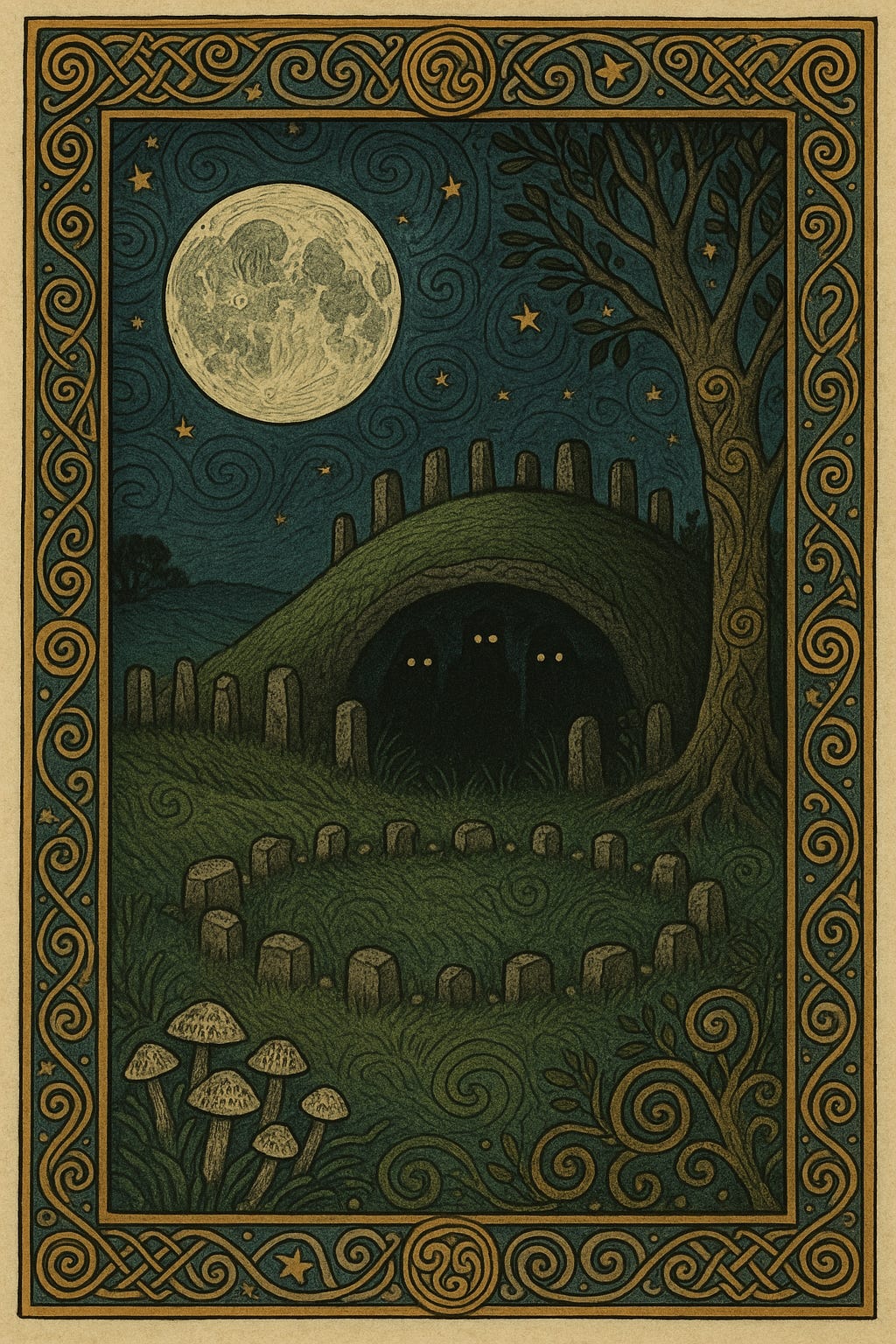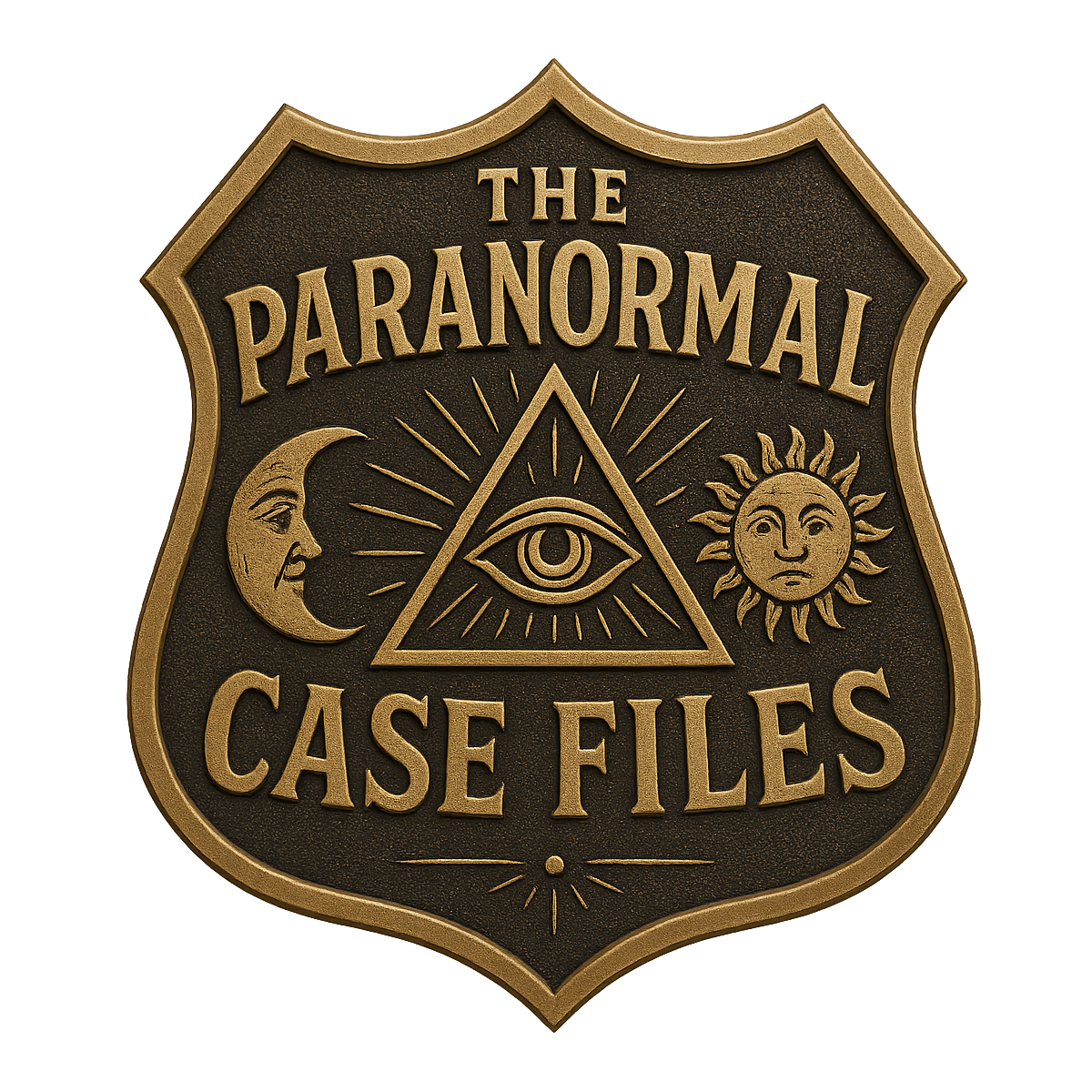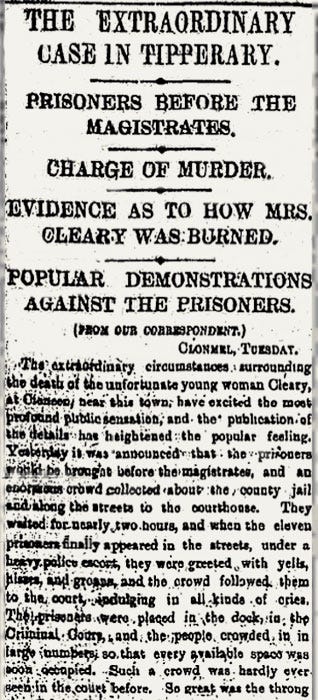📁 Folklore Files: Irish Fairies
These aren't your childhood fair stories.
Irish fairy lore is among the richest and most enduring folk traditions in Europe. At its core lies the belief in the Aos Sí, or "people of the mounds," who are said to inhabit the hollow hills, ancient ringforts, and remote woodlands of the Irish countryside. These beings were believed to be the remnants of the Tuatha Dé Danann, a mythic race of god-like figures defeated and driven underground in the distant past. Others believed the fairies were fallen angels, too good for hell but too proud for heaven.
What distinguishes Irish fairy lore from more modern, sanitised interpretations is its sense of danger and reverence. Fairies were not seen as delightful creatures, but as powerful, capricious beings with their own customs and moral code. They might reward a respectful human with blessings or inflict punishment for slights, real or imagined. To offend the Good People, as they were euphemistically called, was to invite illness, madness, death or worse. Belief in fairies was not merely cultural ornament. It was a living framework used to explain the unexplainable and navigate a world full of uncertainty.
Why Fear Fairies
The fear of fairies in Ireland was rooted in a deep respect for their power and mystery. They were not evil in the Christian sense, but amoral. They followed their own rules, and when those rules were broken, they could react with swift cruelty. Crops might fail. Livestock might die. Children might be taken. Illness could descend without warning.
As Lady Wilde wrote in her 19th-century collection "Ancient Legends, Mystic Charms, and Superstitions of Ireland," the fairies were believed to be easily offended and to retaliate harshly when slighted. A casual comment, a careless action, even building on sacred ground could provoke their ire. Avoiding their wrath became a daily concern, and many rural families observed unwritten rules designed to keep them at bay. These included never speaking ill of “the other folk”, not interfering with known fairy places, and keeping protective objects such as iron nearby.
Things Associated with Fairies: Circles, Trees, and Stones
Irish landscapes are dotted with sites associated with fairies. Chief among these are fairy rings, which are naturally occurring circles of mushrooms. These were believed to be the result of fairy dances. Stepping into one could result in being trapped in the fairy realm, where time passed differently. People might return from such encounters changed, confused, or driven mad.
Lone hawthorn trees were also sacred. Known as fairy trees, they were often left untouched in the middle of fields or along roadsides, even at great inconvenience. Cutting one down was considered a reckless act that could bring terrible misfortune. In 1999, a construction project in County Clare was famously rerouted to avoid damaging a hawthorn tree believed to be a fairy dwelling.
Ancient ringforts and standing stones were likewise avoided. These sites were seen as entrances to the Otherworld and were treated with caution. Disturbing them was thought to invite spiritual retribution. Archaeologist Dáithí Ó hÓgáin, in his book "The Sacred Isle," noted that these beliefs persisted well into the modern era, long after Christianity had taken root.
Belief Around People Being Swapped with Fairies
One of the most unsettling aspects of Irish fairy lore is the belief in changelings. A changeling was thought to be a fairy or fairy-crafted imitation left in place of a stolen human being. Infants were the most common victims, but adults could be taken as well. The real person would be spirited away to the fairy realm, while the changeling, often sickly or strange, remained behind.
This belief served as a way to explain sudden changes in behaviour or health. A child who stopped thriving or began acting oddly might be suspected of being a changeling. Adults who developed mental illness or dementia could be seen as having been taken by the fairies. It was not always an act of malice. In some tales, the fairies took humans to use as musicians, nurses, or companions, and only left a substitute to avoid detection.
How to Spot a Changeling
Spotting a changeling involved identifying physical or behavioural abnormalities. A child who cried incessantly, refused to feed, or looked unusually aged might raise suspicion. Some believed changelings were unnaturally intelligent or displayed knowledge beyond their years.
Folk tests for identifying changelings often involved trickery. Leaving out unusual items like eggshells filled with water might provoke the changeling into speech or laughter, revealing its inhuman nature. The 19th-century folklorist Thomas Crofton Croker recorded several such tales in his collection "Fairy Legends and Traditions of the South of Ireland."
In one story, a woman left eggshells beside the fire, pretending to cook. Her infant, believed to be a changeling, laughed and declared it had seen many strange things in its time but never eggshell broth. This was taken as proof of its fairy origin.
Ways of Removing a Changeling and Returning Loved Ones
Once someone was believed to be a changeling, the folk remedies were often harsh and violent. The goal was to either drive out the changeling or compel the fairies to return the stolen person. Burning was a common tactic. The suspected changeling might be held near or over a fire, or even placed in an oven. Cold water immersion was another method. Dousing or submerging the person in a river was thought to force the fairies to abandon the deception.
Iron, which was believed to repel fairies, might be used to threaten or harm the changeling. Other remedies included beatings, starvation, or the administration of herbs.
These practices were not born of cruelty for its own sake. They were acts of desperation by people who genuinely believed they were saving their loved ones. However, the results were often tragic.
The Story
County Tipperary, Ireland. 1895.
It was a cold spring in Ballyvadlea, a rural pocket of County Tipperary where old beliefs held firm. The year was 1895, but in many homes, the grip of folklore was far stronger than the hand of modern science. Electricity had not yet reached these cottages. The land was hard, and the people were harder. In these parts, the Good People were spoken of in low voices. Fairies were not fairy tales. They were explanations for sickness, death, and madness. They were feared and respected.
In this small village lived Bridget Cleary, a woman who, by all accounts, did not fit the mould of a peasant wife. She was 26 years old, successful, educated, fashionable, and known to ride her bicycle alone to deliver eggs to customers. She kept her own hens, managed her own business that made and mended dresses. To many, she seemed more modern than the village around her. She was also married to Michael Cleary.
Michael was a cooper by trade, a barrel-maker. But work was becoming scarce. His father had recently died, leaving a weight on his shoulders that he could not shift. He was proud, devout, and deeply insecure. In contrast to Bridget’s independence, Michael was seen as withdrawn. He had moved into Bridget’s family home after they married, living with her father Patrick Boland. That alone was enough to turn heads. It was usually the woman who left her kin to follow her husband. But not in Bridget’s case. She had her own way of doing things.
Their life was quiet but tense. Bridget's autonomy, unusual for a woman in rural Ireland, became a source of gossip. Her assertiveness in the home. Her willingness to challenge Michael in public. These things did not go unnoticed. The neighbours whispered. Some found her boldness inspiring. Others, troubling.
When Bridget fell ill in early March, the rumours quickened. She had caught a chill, or so it seemed, after walking to deliver eggs to a nearby village. But it lingered. She became feverish, weak, and unsteady. Some said she had been too close to a fairy fort. Others said she had spoken the wrong words aloud. Michael watched her change. In her fever, she said strange things. She spoke sharply and refused to eat.
Michael began to fear what the neighbours already suspected: that his real wife had been taken by the fairies and a changeling had been put in her place.
The neighbours believed it too. One by one, they arrived at the cottage to help. Not with medicine, but with ritual. An elderly woman offered herbs, wwhile others murmured prayer. A neighbour named Jack Dunne spoke openly of changelings and how to drive them out. They gave her potions, forcing her to swallow them while reciting prayers. They shook her. Questioned her. Watched for signs. Michael grew more convinced each day that Bridget was gone.
On the night of March 15, 1895, Michael performed his own ritual.
He lit a fire in the hearth. He held Bridget down, surrounded by neighbours and relatives. He shouted questions, demanding her true name. He forced more herbs into her mouth, a deadly mixture of foxglove and water. He held her over the flames. She cried out, struggled, begged. “Give me my Bridget back!” he shouted over and over as she burned.
Then, Michael did the unthinkable. He threw lamp oil on his wife and set her on fire.
Bridget Cleary died in agony, surrounded by those who should have protected her. Michael buried her body in a shallow grave not far from their home, beneath a pile of loose stones.
Days later, a priest visited Michael. Distraught, Michael confessed. But he did not admit murder. He insisted that his real wife had been taken by the fairies and would return, riding a white horse from the nearby fort. He claimed that by destroying the changeling, he had forced the Good People to bring Bridget back.
The priest did not share his belief. He notified the police.
Bridget's body was exhumed and found with extensive burns. Michael and several others were arrested. During the trial, the courtroom struggled with the absurdity and horror of the story. But Michael was calm. He maintained that he had not killed his wife. He had rescued her soul.
Michael Cleary was sentenced to twenty years of penal servitude for manslaughter. Others received lesser sentences. The case was widely reported in newspapers across Britain and Ireland. Bridget became known as "the last woman burned as a witch in Ireland," though she had never been accused of witchcraft.
Her crime, in the eyes of some, was simply being too independent. Too modern. Too bold.
Bridget Cleary did not die because she was a fairy. She died because people believed she might be.
The old stories had power. In Ballyvadlea, they were more than stories. They were rules. And when those rules were broken, they had consequences. Bridget's fate was sealed not by fairies, but by fear. By control. By the belief that the world was still ruled by unseen forces that demanded obedience.
It is easy to dismiss such stories as relics of the past. But the line between belief and brutality is thin, and the story of Bridget Cleary stands as a terrible reminder of what happens when folklore becomes law.
Irish fairy lore is haunting, beautiful, and deeply complex. It speaks to a time when the world was full of spirits, and every misfortune had a supernatural explanation. But it also reminds us that belief can be dangerous. The fear of the Other Crowd led to rituals of protection, but it also led to real-world violence against the vulnerable.
The fairies, if they exist, may not be malicious. But history has shown that those who believe in them can be. It was not always the Good People who brought harm. More often, it was those trying to protect their loved ones from the imagined threat.
Belief, in the end, was the most powerful force of all.








I especially like this one, thanks for sharing!
Love what you “Stack”. Please keep this going!